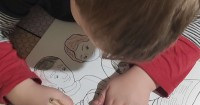How coloring can help in classroom activities
Coloring (and drawing) can build on imagination and influence young students to think of new ideas on their own naturally. Coloring is also a great sitting-still activity. It encourages kids of all ages and activity levels to slow down and focus on one specific task. Setting aside a reasonable amount of time for a student to practice focusing on a specific task can improve this skill as they move forward in grades and skill levels.
Another example of why coloring in the classroom is essential is because some educational content might be too complex for our youngest learners’ comprehension. In this case, a coloring page with the taught skill can reinforce learning and include self-paced, creative-expression activities. While we always provide fun activities, we aim to reinforce health and educational concepts with students engagingly and repetitively.
More and more teachers are becoming afraid of being caught providing activities to their students that have little or no educational value. Today’s classrooms have become all about academics and getting students reading and writing before they can walk. It may sound funny, but it is all true. There are many things to be said for the classroom activities, and of course, there may also be some research to back the benefits of including them in today’s classrooms. Learning to color is a skill students need to develop, like learning to hold a pencil. Here are just a few of the many more benefits of including coloring in your classroom.
The benefits of students coloring in class are numerous. Grab some ideas to be better prepared to tell your administration why allowing students to color is important. Lately, more and more teachers are becoming afraid of being caught providing activities to their students that have little or no educational value. Today’s classrooms have become all about academics and getting students reading and writing before they can walk. Do you remember playing in kindergarten, the board games day, or puzzle centers? There are many things to be said for these activities and research to back up the benefits of including them in today’s classrooms.
Learning to color is a skill students need to develop, like learning to hold a pencil. Here are just a few of the many more benefits of including coloring in your classroom.
Coloring vs. creativity.
Students are free to create imaginary worlds through coloring. They can dream it and draw it. Usually, there are no hard and fast rules regarding a box of crayons and a piece of paper.
Coloring is a time to enjoy the process.
A great way to encourage this creativity is during writing. Allow time during your writing to have students draw out their stories. We are often pressed for time, but students love to draw elaborate pictures, and best practices for writing stories ask for detailed pictures. Lots of detailed illustrations on every page often enhance the story. Start with publishing a story with detailed illustrations at least once a quarter.
Coloring in the classroom is a great way to reach those kinesthetic and visual learners. Encourage their creativity by having them draw out vocabulary words, draw a picture to show their understanding of a science concept, or even have them write their sight words in new and fun ways using crayons. Crayons have a more tactile experience than just using markers, which will help to make their learning stick.
Students are free to create imaginary worlds through coloring. They can dream it and draw it. Usually, there are no hard and fast rules regarding a box of crayons and a piece of paper.
Coloring is a time to enjoy the process.
A great way to encourage this creativity is during writing. Allow time during your writing to have students draw out their stories. We are often pressed for time, but students love to draw elaborate pictures, and best practices for writing stories ask for detailed pictures. Lots of detailed illustrations on every page often enhance the story. Start with publishing a story with detailed illustrations at least once a quarter.
Coloring in the classroom is a great way to reach those kinesthetic and visual learners. Encourage their creativity by having them draw out vocabulary words, draw a picture to show their understanding of a science concept, or even have them write their sight words in new and fun ways using crayons. Crayons have a more tactile experience than just using markers, which will help to make their learning stick.

